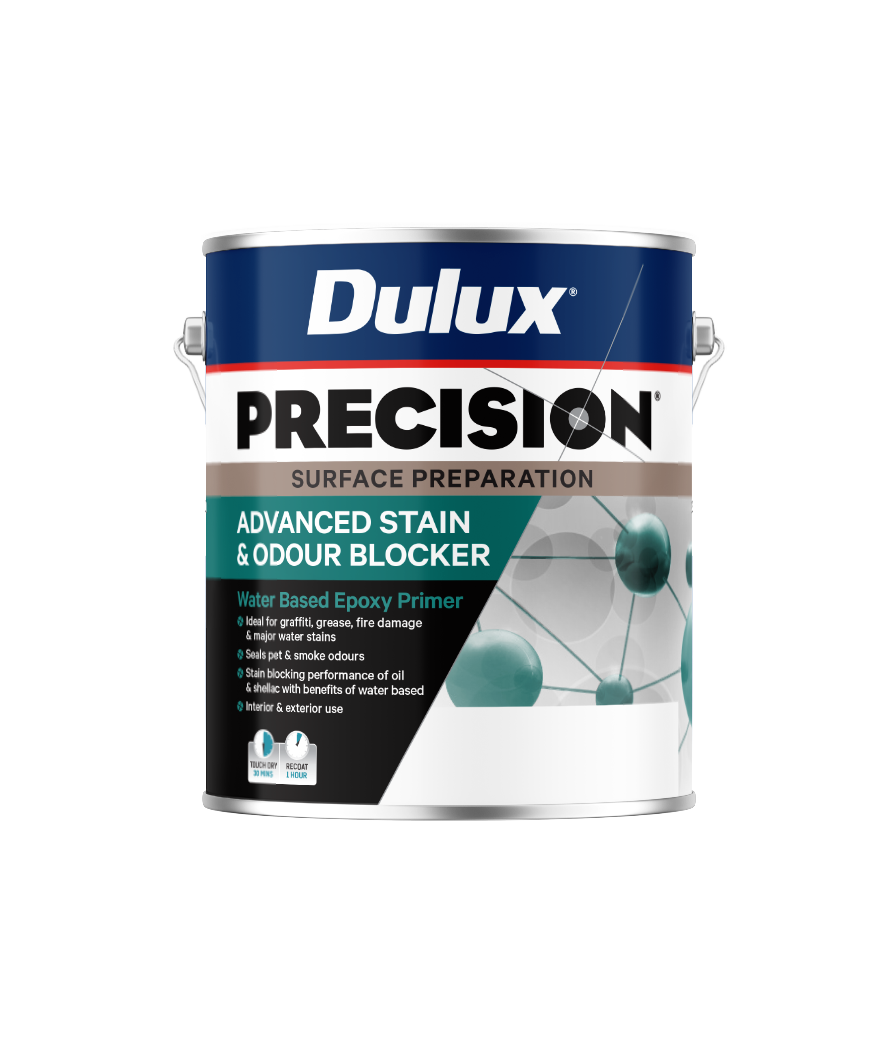PRECISION® Advanced Stain & Odour Blocker

About PRECISION® Advanced Stain & Odour Blocker
Dulux PRECISION® Advanced Stain & Odour Blocker is ideal for severe stains caused by graffiti, grease, and major water and fire damage. The water-based coating offers the superior stain blocking performance of an oil and shellac-based undercoat with the convenience of low odour, fast-drying and water wash-up.
Downloads
Application
At a glance
- Ideal for heavy stains such as graffiti
- Stain blocking performance of oil & shellac-based undercoat
- Water wash up
- Available in 1L
- Interior and exterior use
Areas to use
Surfaces
• Paper-faced plasterboard
• Timber
• MDF
• Chipboard
• Plywood
• Aged enamel
• Brick
• Render
• Masonry
• Concrete
• Cement sheet
• Cladding
• Previously painted surfaces and suitably primed steel
Previously Painted Surfaces
Remove as much of the stain as possible by cleaning with Selleys® Sugar Soap, sanding or scraping.
Previously painted surfaces:
Scrape off loose and flaking paint. Wash with Selleys® Sugar Soap, to remove grease and grime.
Fill nail holes and cracks with a suitable filler, then sand smooth.
Unpainted Surfaces
Bare timber including weatherboards and hardboards:
Sand bare timber to a clean surface and dust down. Fill nail holes and cracks with suitable filler, then sand smooth and dust off.
Chalky surfaces:
Sand back to a strongly bound surface and dust off.
High gloss or hard, aged enamel surfaces:
Sand to a dull finish.
Plasterboard, masonry, MDF, render, concrete, cement sheet, suitably primed steel, galvanised iron and ZINCALUME®:
Fill holes and other imperfections with a suitable filler, sand and dust off.
Allow cement render and concrete to properly cure before priming.
Brush, roller
• Stir well before use with a broad flat paddle using an up and down scooping action.
• Apply one coat of Dulux PRECISION® Advanced Stain & Odour Blocker.
• For heavily stained surfaces on paper-faced plasterboard where there is a different texture between paper and joining compound, or where extra filling and smoothness are required, a second coat may be required.
Tinting: For stain blocking applications DO NOT TINT. For use as a primer Dulux PRECISION® High Opacity Stain
Unused paint
Do not pour leftover paint down the drain.
Unwanted paint should be brushed out on newspaper and allowed to dry, and then disposed of via domestic waste collections.
For more information on responsible disposal of paint and packaging visit paintback.com.au or painttakeback.co.nz
Empty paint containers
Leave empty paint containers open in a well-ventilated area to dry out. When dry, recycle the container via steel can recycling programs.
Disposal of empty paint containers via domestic recycling programs may differ between local authorities. Check with your local council first.
Do not reuse container unless thoroughly decontaminated.
For more information on responsible disposal of paint and packaging visit paintback.com.au or painttakeback.co.nz
Make confident decisions about your project needs with support from our wide network of colour and product specialists, tools, programs and apps — or chat to one of our expert consultants now.

Imagining how a space will feel in a new colour scheme is hard. Save time and gain colour confidence the smart way with personal guidance from an expert Dulux Colour Consultant.
Learn more-->Have you got the vision but need some help with application? Connect with the right local painter to suit your needs.
Find a painter-->
